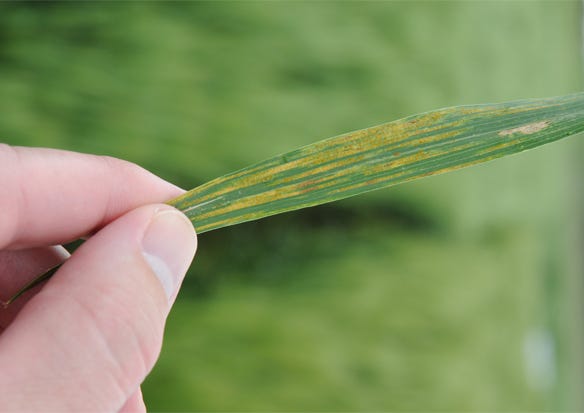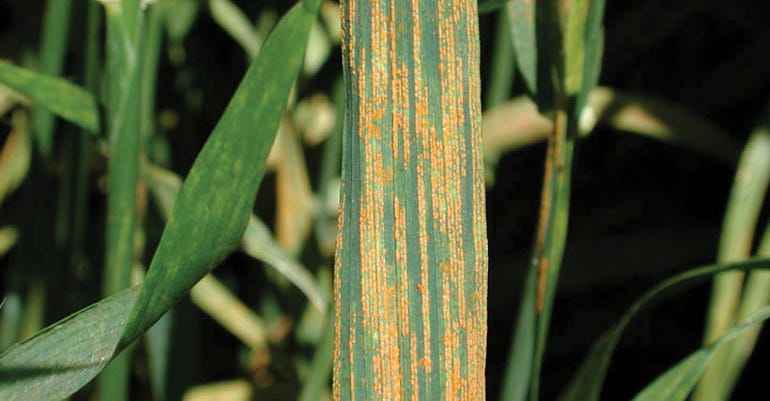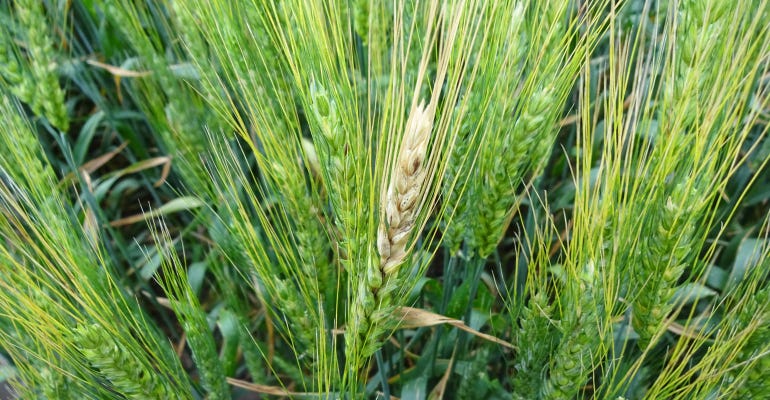May 1, 2019

The good news is the hard red winter wheat crop is growing like crazy and looking really good with all the subsoil moisture stored up from the wet winter.
The bad news is, all that wet weather pushes up the risk of foliar diseases and wheat growers in the central and southern U.S. need to be especially vigilant in scouting for disease and protecting the crop.
Mark Lubbers, WestBred wheat technical product manager, identifies four fungal infections requiring early identification and treatment.
1. Powdery mildew. Plants affected by powdery mildew will display white powder-like spots (resembling cottony growth) on leaves and stems. Typically, the upper surfaces of the lower leaves are the most affected areas. Symptoms are visible early in the season and can be particularly prevalent during mild (between 59 and 70 degrees F), wet conditions.
If these conditions persist, the entire leaf can turn yellow and die, reducing the plant’s yield potential. This is most often the case in Central and Eastern Kansas and in Nebraska fields with dense stands and high nitrogen fertility.
Lubbers warns this may be a year that requires early-season control and maybe a second spray. When it comes to foliar disease control, growers mostly think about protecting the upper leaves, specifically the flag leaf.
If early-season powdery mildew pressure is moderate to heavy on the lower leaves, however, a fungicide will be needed to protect the developing tillers, Lubber says. A second spray may be necessary again at flag leaf if the disease is visible three to four weeks after the first spray.
2. Stripe rust (yellow rust). Stripe Rust, a potentially major concern across most of Kansas, Nebraska and Colorado, is characterized by its yellow-orange pustules that appear primarily on the leaves; however, they can also appear on the glumes and base of the awns. These pustules differ from leaf rust and stem rust as they are generally arranged in a row or stripe.
Stripe rust typically appears earlier in the season since its development is favored by cool (between 50 and 65 degrees), humid conditions. Like powdery mildew, when daytime temperatures rise above 80 degrees, Stripe rust development will generally cease or be severely restricted.
 STRIPE RUST: The fungal disease stripe rust is characterized by yellow postules that form strips on leaves.
STRIPE RUST: The fungal disease stripe rust is characterized by yellow postules that form strips on leaves.

Genetic resistance and timely fungicide applications can help control the disease and decrease potential yield loss. When applying fungicides, it’s best to wait until after the flag leaf is at least 50 percent emerged to ensure adequate coverage since most fungicides have little mobility in the plant.
3. Leaf rust (brown rust). Leaf rust is the most common of the three rust diseases that affect wheat in the Central Plains. It is typically found throughout the eastern half of Kansas and Nebraska, but it can also occur in western Kansas and Nebraska and eastern Colorado.
Leaf rust is characterized by its small reddish-brown pustules found on the upper surfaces of the leaves. Pustule colors of leaf rust and stem rust may look similar, but a key difference is that leaf rust pustules are small and will only appear on the leaves, while stem rust pustules are larger and can be found on the leaves, stems and heads. Mild temperatures (between 68 and 77 degrees) and humid conditions are optimum for disease development.
 LEAF RUST: This fungal disease leaves small reddish-brown spots on the tops of leaves.
LEAF RUST: This fungal disease leaves small reddish-brown spots on the tops of leaves.

Controlling leaf rust is very similar to controlling stripe rust and includes selecting a variety with genetic resistance and applying a timely fungicide. Due to warmer temperatures required for leaf rust development, make sure to follow all fungicide label requirements regarding growth stages and pre-harvest intervals.
4. Fusarium head blight (head scab). Fusarium head blight is a major disease for wheat growers in the eastern half of Kansas and Nebraska. In 2018, localized outbreaks did occur in western Kansas and eastern Colorado; therefore, growers need to be aware of the conditions favorable for disease infection. Wheat planted in corn residue is at primary risk since the pathogen that causes FHB is also responsible for gibberella stalk rot and ear rot in corn.
As the wheat crop reaches flowering, it is most vulnerable to FHB infection. High humidity and temperatures between 75 and 85 degrees are ideal for infection. Early symptoms include spikelets and entire heads appearing prematurely whitened or bleached.
 FUSARIUM: Wheat planted into corn residue is most susceptible to this fungal disease which usually appears about flowering time.
FUSARIUM: Wheat planted into corn residue is most susceptible to this fungal disease which usually appears about flowering time.

Fungicides provide partial suppression of FHB (particularly the triazole class of fungicides, including Prosaro fungicide). To be effective, the fungicide must be applied at flowering with uniform coverage. In areas prone to FHB infection, it is advised to combine fungicide applications with resistant varieties such as WB4269 or WB4699.
These four fungal diseases are among the most prevalent and costly to wheat growers in the central U.S. — but they are definitely not the only threats to a profitable growing season. For additional agronomic tips or to learn which varieties are the best fit for your acres, visit westbred.com or contact Lubbers at [email protected].
Source: WestBred Wheat, which is solely responsible for the information provided and is wholly owned by the source. Informa Business Media and all its subsidiaries are not responsible for any of the content contained in this information asset.
You May Also Like




